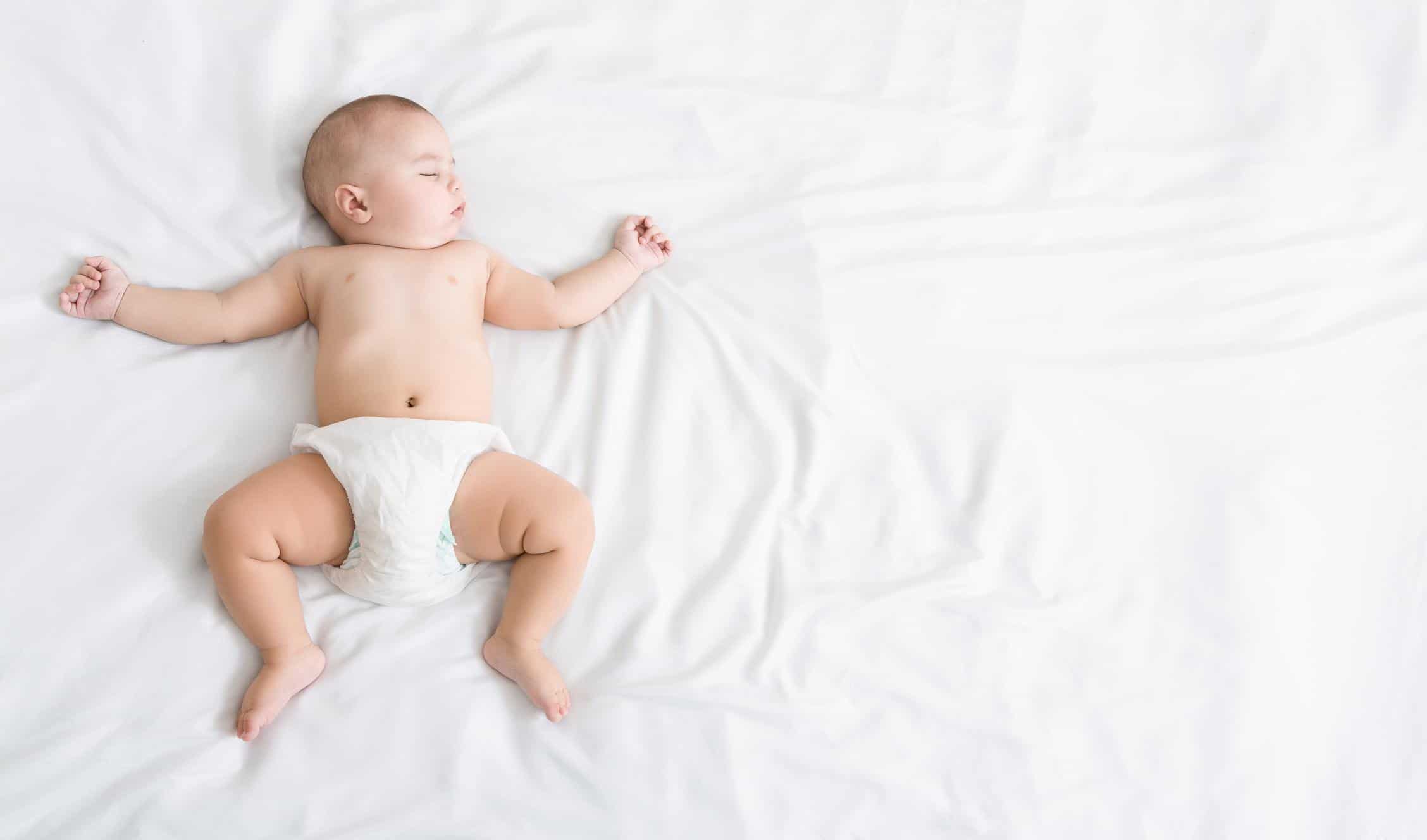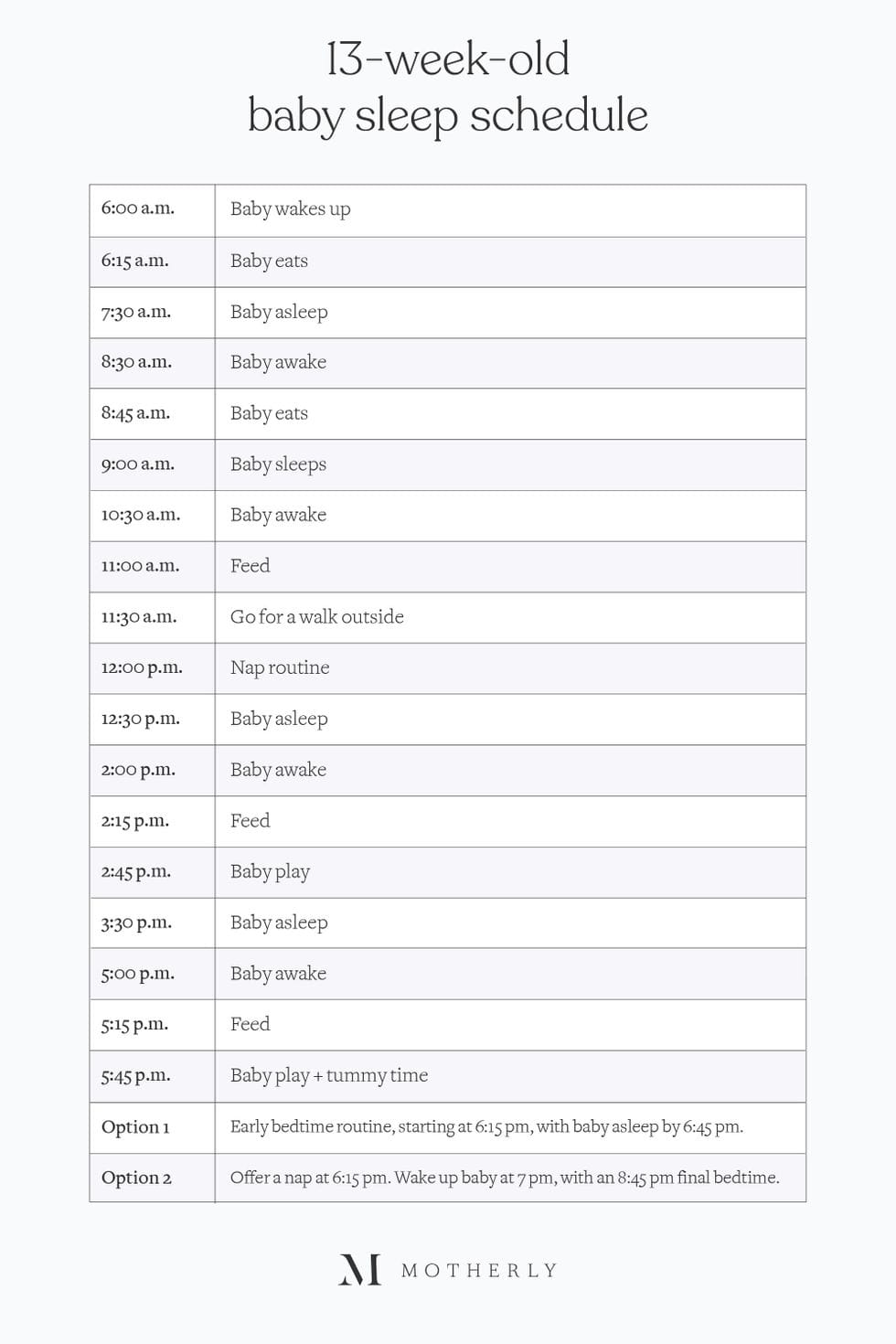How much sleep does a 13-week-old baby need?

Here's our expert guidance & tips on your infant's sleep schedule.
Table of Contents
If you have a baby, chances are you spend A LOT of time thinking about their sleep habits. Are they getting enough? How much do they really need? Will they ever sleep through the night, or is that just a parenting mirage?
If you’re worried about your baby’s sleep routine, we’ve created a week-by-week guide to help you find the answers you need and develop an infant sleep schedule that works for your baby and your family. The first step to a healthy sleep pattern is a regular sleep schedule—we’ve got you covered, mama.
To help with the early months of infant sleep, we’ve put together a handy sleep schedule of how much your 13-week-old is sleeping.
How much sleep does a 13-week-old baby need?
Infants up to three months old should be getting 14-17 hours of sleep within a 24-hour period, according to the National Sleep Foundation. By three months of age, many babies will have settled into a predictable sleep routine. Your baby likely takes two to three naps during the daytime, with longer stretches of nighttime sleep compared to those early newborn weeks.
Remember, all babies are different and they all develop at their own pace—that includes sleeping, too!
“This is the stage I recommend parents start to really think about moving their baby’s bedtime up if they were on a later bedtime. You can do this by gradually adjusting their bedtime 20-25 minutes each night and adjusting the last nap of the day if needed to close that gap,” says Rachel Mitchell, founder of My Sweet Sleeper. “You may also be wondering when you can start ‘sleep training’ or teaching those independent skills. Their internal sleep clock is still forming and your baby still relies on you to help them self-regulate, but you can definitely start gradually introducing more independence by continuing to put your baby down awake, and pausing a bit longer before responding to your baby for wake-ups.”
Related: Baby Feeding Guides & Schedules
At three months old, your baby can be placed in their crib while awake, but drowsy and ready for bed. Rocking or nursing your baby to sleep is fine, of course! If that’s what works for you, that’s what works for you. Though your baby will likely come to expect sleep assistance from you the longer you provide it.
If you’re looking to make sure your sleep routine for your 13-week-old is a solid one, here’s a sample sleep schedule of what one 24-hour period with a 13-week-old baby would look like. (Note: this is meant to be a rough guide of what you can expect your baby to do; however, this is not meant to be a strict sleep schedule to adhere to.)
13-week-old baby sleep schedule

OPTION 1: Early bedtime routine, starting at 6:15 pm, with baby asleep by 6:45 pm.
OPTION 2: Offer a nap at 6:15 pm. Wake up baby at 7 pm, with an 8:45 pm final bedtime.
What are wake windows and why are they important?
A wake window is the period of time a baby can stay awake in between naps without being overtired. Wake windows for a 13-week-old.
For a 13-week-old infant, wake windows could be as long as an hour or longer. Though they’re likely only spending seven to 10 hours awake within a 24-hour period, and they’re still too little to stay awake for that many hours in a row (and will be for a very long time)!
During your infant’s wake window, you can play with baby toys, sing to them, cuddle, work on tummy time, let them enjoy a baby mat while lying flat on their back, or have some swing time while you putz around the house. Whatever you want to do with your little one is up to you!
Related: 4-month-old baby milestones
Sleep tips for infants
Developing a solid sleep schedule and daily routine is important for your baby and your entire family. By now, your baby likely already has one—they’re creatures of habit that way. Remember, flexibility is key for both you and your baby.
Remember, try not to keep your baby awake if they don’t want to be. An overly tired infant can have trouble settling down and falling asleep at all, even if they’re exhausted. Keeping them awake longer does not mean they’ll sleep longer (and this remains true for the duration of childhood).
- Always place your baby on their back to sleep, not on the stomach or side. This helps to reduce the risk of Sudden Infant Death Syndrome (SIDS) and Sudden Unexplained Infant Death (SUID). The American Academy of Pediatrics initiated the “Back to Sleep” movement in 1992, and rates of SIDS/SUID have decreased dramatically since.
- Do not put anything else in the crib or bassinet. Keep plush toys, pillows, blankets, loose sheets, and bumpers out of your baby’s crib or bassinet for similar reasons as above.
- Avoid overheating. You can dress them according to the room’s temperature. Using a sleep sack is a great sleep time addition—it keeps your baby warm, but their arms remain free to avoid overheating. You can get lighter ones for warmer weather, and fleece or flannel sacks for winter.
- Try putting your baby down drowsy but awake. This will help them develop self-soothing tactics and get used to falling asleep on their own.
- Use a white noise machine. Whether your house is quiet as a mouse, or you’ve got other kids running around making noise, a white noise machine can help your baby feel soothed (and possibly tune out) in their surroundings.
- Snuggle it up. Your baby wants your cuddles as much as you want to give them—especially if they’re fussy. A calm bedtime baby means a better chance for more sleep for everyone!
A version of this story was published August 24, 2021. It has been updated.


































